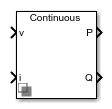Power Measurement
计算单相实际功率和无功功率
库:
Simscape /
Electrical /
Control /
Measurements
描述
Power Measurement 模块测量单相网络中元件的实际功率和无功功率。该模块输出您指定的每个频率分量的功率数量。对于三相测量,请考虑使用 Three-Phase Power Measurement 模块。
使用此模块可测量正弦和非正弦周期性信号的功率。
对于连续时间运行,将采样时间参数设置为 0,对于离散时间运行,则显式设置为特定值。
使用谐波次数参数指定由要包含在功率输出中的所有频率分量组成的向量:
要输出 DC 分量,请指定
0。要输出对应于基频的分量,请指定
1。要输出对应于更高阶谐波的分量,请指定
n > 1。
方程
对于每个指定的谐波 k,模块根据相量方程计算实际功率 Pk 和无功功率 Qk:
其中:
对于 DC 分量 (k = 0),G 等于
0.25;对于 AC 分量 (k > 0),则等于0.5。是 k 分量输入电压的相量表示形式。
是 的复共轭,后者是 k 分量输入电流的相量表示形式。
模块使用以下关系估计实时 k 分量电压和电流相量:
在这些相量方程中:
V(t) 和 I(t) 分别是输入电压和输入电流。
T 是输入信号的周期,或是其基础频率 F 的倒数,这两者是等效的。
如果输入信号具有有限谐波数 n,则可以根据其分量计算总实际功率 P 和总无功功率 Q:
对 Q 求和不包括 DC 分量 (k = 0),因为该分量仅对实际功率有贡献。
端口
输入
输出
参数
扩展功能
版本历史记录
在 R2017b 中推出
